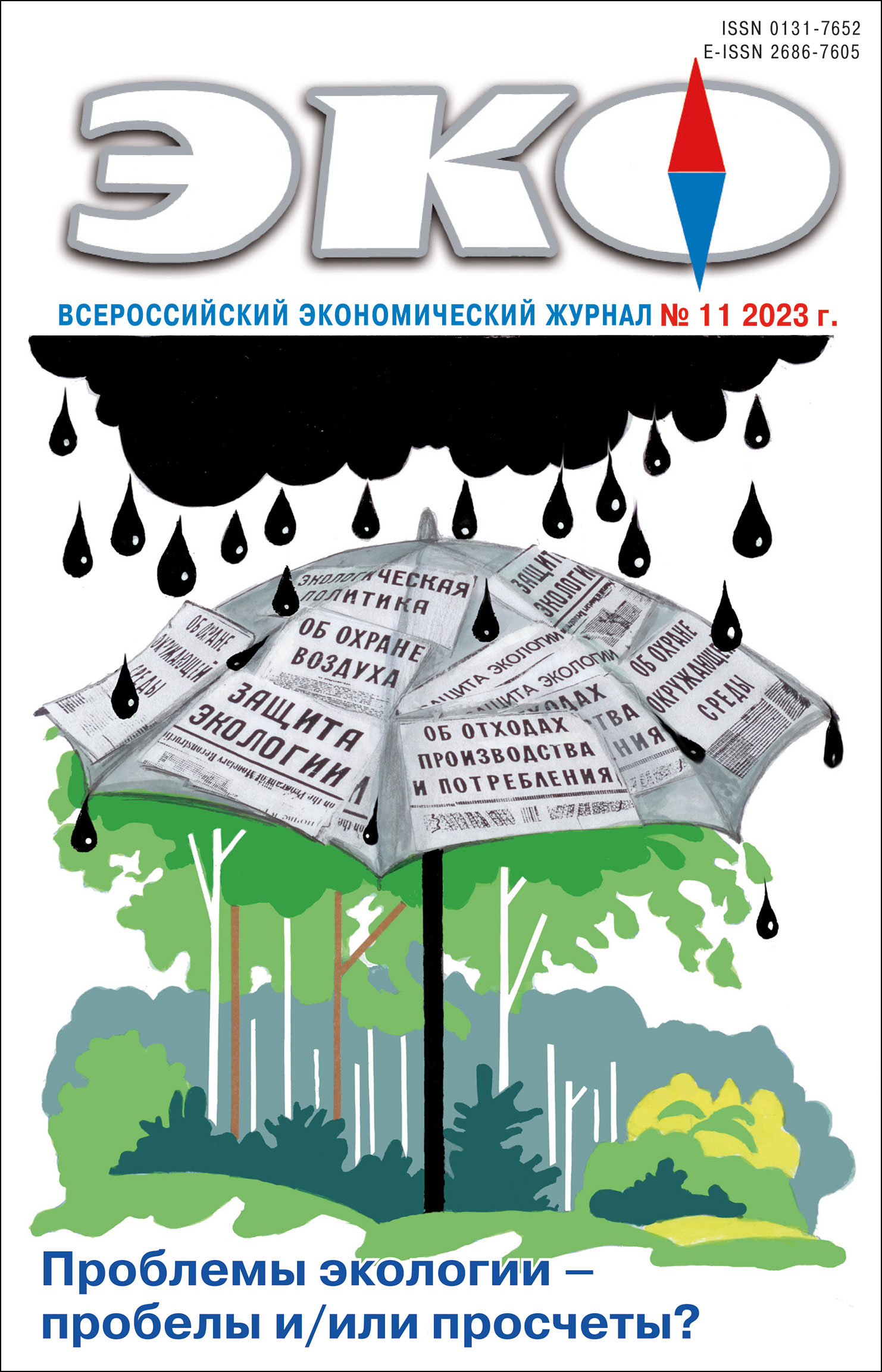ECONOMIC SOCIOLOGY AND DEMOGRAPHY
Published 2023-10-27
Keywords
- private property; personal property; privatization; discourse; Address to the Federal Assembly; attitude to property
How to Cite
1.
Cherkashina Т. Personal, Private, Proprietary – What does Property they Own Mean to Russians?. ECO [Internet]. 2023 Oct. 27 [cited 2025 Oct. 13];53(11):110-3. Available from: https://ecotrends.ru/index.php/eco/article/view/4681
Abstract
The paper utilizes normative documents to describe the institutional conditions of formation and increase of personal and private property of the population of the USSR and the Russian Federation, in which the basic object of ownership is housing; the characteristics of the public state discourse in relation to such property are defined on the example of the messages of the President of the Russian Federation to the Federal Assembly, and the data of sociological surveys and household surveys show how Russians themselves treat it. The state policy is shifting from encouraging citizens to acquire property, primarily residential real estate, and bringing it into the zone of formal (registrable) rights to the use of property in controlling functions. In the public discourse since the early 2000s, the emphasis has shifted from the protection of citizens’ property rights to financial instruments related to it (housing mortgage, property taxation); property is associated with the private, family sphere. The attitude of the population to property is generally consistent with this discourse: the dominant object of ownership of the majority of Russians is occupied housing; its purchase, but not its possession, is problematized.References
- Аксенов К.Э. Куда вас теперь не пускают: как менялась публичная доступность пространства в жилых кварталах Санкт-Петербурга в XXI веке? / Геоурбанистика и градостроительство: теоретические и прикладные исследования. Отв. ред. А.Г. Махрова. М.: Географический факультет Московского государственного университета им. М.В. Ломоносова, 2021. С. 223–239.
- Аксенов К.Э. Тенденции изменения публичной доступности пространства в постсоветском метрополисе: сжатие или расширение? // Известия Русского географического общества. 2011. Т. 143. № 2. С. 58–70.
- Бессонова О.Э. Жилье: Рынок и раздача. Новосибирск: «Наука». Сибирская издательская фирма, 1993. 160 с.
- Богомолова Т.Ю., Черкашина Т.Ю. Нефинансовое богатство российских домохозяйств: собственность и налоги // Мир России. Социология. Этнология. 2021. Т. 30. № 3. С. 51–77. DOI: 10.17323/1811-038X-2021-30-3-51-77
- Борщевский Г. Отражение ценностей российского общества в Посланиях Президента Федеральному Собранию // Социологическое обозрение. 2022. Т. 21. № 3. С. 84–103. DOI: 10.17323/1728–192x-2022–3–84–103
- Вайс Х. Мы никогда не были средним классом. Как социальная мобильность вводит нас в заблуждение / Пер. с англ. Н. Проценко; под науч. ред. А. Смирнова; Нац. исслед. ун-т «Высшая школа экономики». М.: Изд. дом Высшей школы экономики, 2021.
- Волков Д., Колесников А. Новая русская мечта: частная собственность для детей / Московский Центр Карнеги. 2018. URL: https://carnegieendowment.org/files/Kolesnikov_Volkov_Rus_web_final.pdf (дата обращения: 30.06.2023).
- Гонтмахер Е.Ш. Национальные проекты: первые итоги реализации // SPERO. 2008. № 8. Весна–Лето. С. 119–134.
- Готово ли российское общество к модернизации? / Под ред. М.К. Горшкова, Р. Крумма, Н.Е. Тихоновой. М.: Издательство «Весь Мир», 2010. 344 с.
- Дятлов В.И. «Частный сектор» советского города: дома, дворы и люди в словах и образах // Ойкумена. Регионоведческие исследования. 2021. № 1. С. 19–29. DOI: 10.24866/1998–6785/2021–1/19–29
- Зюзина Е.Б. Послания Президента Российской Федерации: эволюция месседжей (2012–2019 годы) // Вестник Воронежского государственного университета. Серия: История. Политология. Социология. 2020. № 2. С. 15–20.
- Меерович М.Г. Власть и жилище (жилищная политика в СССР в 1917–1940 годах) // Вестник Евразии. 2003. № 1. С. 5–66.
- Мельников М.В. Отношение новосибирцев к ограждению придомовой территории // Уровень жизни населения регионов России. 2016. № 1. С. 94–104.
- Рощина Я., Илюнькина Н. Анализ влияния мер государственной поддержки ипотечного кредитования на доступность жилья в России: региональный разрез // Деньги и кредит. 2021. № 4. С. 98–123. DOI: 10.31477/rjmf.202104.98
- Собственность и бизнес в жизни и восприятии россиян/ Отв. ред. М.К. Горшков, Н.Е. Тихонова, А.Ю. Чепуренко; Ин-т социологии РАН. М.: Наука, 2006. 392 с.
- Adkins L., Cooper M., Konings M. The asset economy: conceptualizing new logics of inequality // Distinktion: Journal of Social Theory. 2022. Vol. 23. No 1. Pp. 15–32. DOI: 10.1080/1600910X.2021.1904429
- Arundel R., Ronald R. The false promise of homeownership: Homeowner societies in an era of declining access and rising inequality // Urban Studies. 2021. No. 58 (6). Pp. 1120–1140. DOI: 10.1177/0042098019895227
- Attwood L. Privatisation of Housing in Post-Soviet Russia: A New Understanding of Home? // Europe-Asia Studies. 2012. Vol. 64. No 5. Pp. 903–928. DOI: 10.1080/09668136.2012.681243
- Doling J., Ronald R. Home ownership and asset-based welfare // Journal of Housing and the Built Environment. 2010. No. 25. Pp. 165–173. DOI 10.1007/s10901–009–9177–6
- Hillig A. Everyday financialization: The case of UK households // Environment and Planning A: Economy and Space. 2019. No. 51 (7). Pp. 1460–1478. DOI: 10.1177/0308518X19843920
- Hirt S., Petrovic M. The Belgrade Wall: The Proliferation of Gated Housing in the Serbian Capital after Socialism // International Journal of Urban and Regional Research. 2011. Vol. 35, Issue 4. Pp. 753–777. DOI:10.1111/j.1468–2427.2011.01056.x
- Kohl S. The political economy of homeownership: a comparative analysis of homeownership ideology through party manifestos // Socio-Economic Review. 2020. Vol. 18, Issue 4. Pp. 913–940. DOI: 10.1093/ser/mwy030
- Ronald R., Lennartz C., Kadi J. What ever happened to asset-based welfare? Shifting approaches to housing wealth and welfare security // Policy & Politics. 2017. Vol. 45. No. 2. Pp. 173–93. DOI: 10.1332/030557316X14786045239560.
- Vesselinov E., Cazessus M., Falk W. Gated Communities and Spatial Inequality // Journal of Urban Affairs. 2007. Vol. 29, No. 2. Pp. 109–127. DOI: 10.1111/j.1467–9906.2007.00330.x
- Weiss H. Homeownership in Israel: The social costs of middle-class debt // Cultural Anthropology. 2014. No. 29 (1). Pp. 128–149. DOI: 10.14506/ca29.1.08

